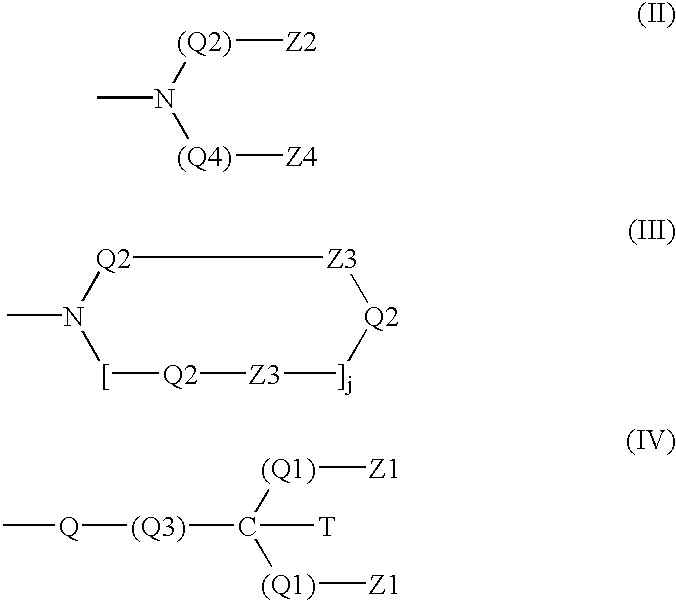Enzymatic detergent compositions
a technology of detergent compositions and compositions, applied in the direction of detergent compositions, soap detergent compositions, organic/inorganic per-compound compounding agents, etc., can solve the problem that no significant cleaning benefit can be expected
- Summary
- Abstract
- Description
- Claims
- Application Information
AI Technical Summary
Problems solved by technology
Method used
Image
Examples
example 1
Bleaching of Tomato-oil Stained Cotton Cloths without and with Addition of Various Metal Catalysts and Lipolase
[0081] The potential for Lipolase to boost the bleaching performance of various metal catalysts was assessed by washing cotton swatches soiled with tomato-oil stains
[0082] Tomato / soy oil stained cloths were added and stirred for 30 minutes at 25.degree. C. (blanks) in the following detergent composition dosed at 2 g / l in Milli-Q water with 0.6 mM CaCl.sub.2 added. Cloth to liquor ratio was 1:40. The pH of the wash solution was 10 at the start of the wash.
[0083] Detergent Composition
1 Anionic surfactant (LAS) 23% Cationic surfactant (Praepagen HY) 0.83% STPP 14.5% Sodium silicate 7.2% Sodium sulphate 30.0% Sodium carbonate 17.5% SCMC 0.38% Tinopal CBS-X 0.06% Tinopal DMS 0.11% Dye CI74160 0.02% Termamyl 60T 0.28% Savinase 12T 0.47% Moisture 5.47%
[0084] In comparative experiments, the same tests were done in the presence of 5 .mu.M of transition metal complex, referred to in ...
example 2
Bleaching of Tomato-oil and Curry-oil Stained Cotton Cloths without and with Addition of Various Lipases and Metal Catalysts
[0133] The potential for various lipases to boost the bleaching performance of various metal catalysts was assessed by washing cotton swatches soiled with tomato / soy oil and with curry / soy oil stains as described in example 1.
[0134] The following detergent composition was used at 1 g / l in Milli-Q water with 0.4 mM CaCl.sub.2 added. Cloth to liquor ratio was 1:40. The pH of the fresh wash solution was 10. After the wash the pH had dropped to about 8. This effect was studied in more detail in example 4.
4 Na-LAS 24.8% Silicate 10.2% STPP 30.8% Sodium Sulphate 21.4% Sodium Carbonate 12.0% Savinase 12T 0.77%
[0135] The following complexes were used:
[0136] 2. [Fe(MeN4Py)Cl]Cl
[0137] 4. [Fe(Metrilen)Cl]PF.sub.6
[0138] 6. [Fe(Bztrilen)Cl]PF.sub.6
[0139] The following commercially available lipases were used:
[0140] 1. L8525 from Candida rugosa ex. Sigma-Aldrich
[0141] 2. L07...
example 3
Bleaching of Tomato-oil and Curry-oil Stained Cotton Cloths without and with Addition of Various Lipases and Metal Catalysts in Various Detergent Formulations
[0161] The potential for various lipases to boost the bleaching performance of various metal catalysts was assessed by washing cotton swatches soiled with tomato-oil and with curry-oil stains as described in examples 1 and 2. The following detergent compositions were used (in weight %)
9 Detergent code Ingredient name A B C D Anionic surfactant (LAS) 24.8 17.3 17.3 15.3 Nonionic surfactant (Synperonic 0 7.5 7.5 6.6 A7) Silicate 10.2 10.1 10.1 8.9 STPP 30.7 31.1 31.1 27.5 Sodium sulphate 21.3 21.3 21.3 18.9 Sodium carbonate 12.0 12.4 12.4 11.0 Sodium percarbonate 0 0 0 6.9 TAED (83%) 0 0 0 2.0 Dequest 2047 0 0 0 2.3 Savinase 12T 1 0.3 0.3 0.7 PH (adjusted with HCl) 10.0 10.0 9.0 9.0 Above detergents were dosed at 1 g / l detergent A in Milli-Q water with 0.4 mM CaCl.sub.2; 3 g / l detergent B in Milli-Q water with 2.0 mM CaCl.sub.2; ...
PUM
| Property | Measurement | Unit |
|---|---|---|
| weight percent | aaaaa | aaaaa |
| weight percent | aaaaa | aaaaa |
| pH | aaaaa | aaaaa |
Abstract
Description
Claims
Application Information
 Login to View More
Login to View More - R&D
- Intellectual Property
- Life Sciences
- Materials
- Tech Scout
- Unparalleled Data Quality
- Higher Quality Content
- 60% Fewer Hallucinations
Browse by: Latest US Patents, China's latest patents, Technical Efficacy Thesaurus, Application Domain, Technology Topic, Popular Technical Reports.
© 2025 PatSnap. All rights reserved.Legal|Privacy policy|Modern Slavery Act Transparency Statement|Sitemap|About US| Contact US: help@patsnap.com



